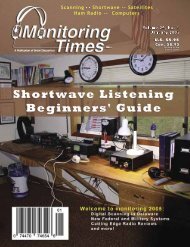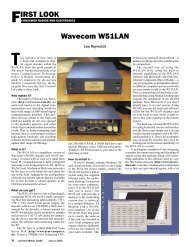RIGHT-click here - Monitoring Times
RIGHT-click here - Monitoring Times
RIGHT-click here - Monitoring Times
You also want an ePaper? Increase the reach of your titles
YUMPU automatically turns print PDFs into web optimized ePapers that Google loves.
❖ QSL Woes<br />
Bob Combs wrote from New Mexico with<br />
a few notes about verifications and AM DX. Bob<br />
believes a DX logging is not complete without<br />
verification from the station – and he’s finding<br />
that verification increasingly difficult to obtain.<br />
Recently, his reply rate is down to about 40%.<br />
The rate is even worse for Mexican stations,<br />
which make up a large part of what he hears. Bob<br />
does report in Spanish and includes money for<br />
return postage, but still doesn’t receive verifications.<br />
He suggests a few possible reasons for the<br />
low returns:<br />
- Secretaries not bothering to forward mail.<br />
- Stations not caring about reports.<br />
- Lack of engineers. (Most stations use contract<br />
engineers who serve several stations.)<br />
- Streaming broadcasts online. (Hearing a station’s<br />
programming over a great distance is<br />
no longer unusual.)<br />
I suspect a combination of all four is involved.<br />
More recently, with massive ownership<br />
consolidation, many stations do have a fulltime<br />
engineer. They may serve all of the company’s<br />
stations in a given market – but likely have<br />
no duties elsew<strong>here</strong>. Whatever you may think<br />
of these large group owners, they usually get<br />
engineering right. They also usually control<br />
the stations with the best signals – the ones you<br />
probably already verified years ago...<br />
Some New Mexico stations do QSL! (Doug<br />
Smith)<br />
For Bob, follow-up emails have been quite<br />
successful. Bob emailed reports to ten stations<br />
that didn’t respond to requests 12 years ago. All<br />
ten replied – two even sending verifications via<br />
postal mail.<br />
To this end, Bob suggests a column giving<br />
station email addresses that normal websurfers<br />
can’t find. I’m not any better at finding these<br />
than anyone else! – but if anyone out t<strong>here</strong> has<br />
any suggestions, any addresses they’ve found to<br />
work, I’ll be glad to publish them in this column.<br />
Please be sure the station is OK with such addresses<br />
being published.<br />
❖ Another News/Talk<br />
Station on FM<br />
For years, it’s been the rule in radio: news/<br />
talk formats on AM, music on FM. The mold was<br />
broken <strong>here</strong> in Nashville twenty years ago when<br />
news/talk 99.7 FM (W)WTN came on the air.<br />
It was followed a few years later by all-sports<br />
WGFX 104.5. Today, Nashville has a news/talk<br />
station and two all-sports operations on FM, and<br />
is by no means unusual.<br />
Larry, W9QR writes with news of an FM<br />
relay of a well-known news/talk station in Indiana.<br />
Classic rock station WFWI-FM flipped,<br />
on April 1 st , to a simulcast of WOWO-1190 Fort<br />
Wayne. Years ago, WOWO was briefly sold to<br />
the owners of a daytime-only station on the same<br />
frequency in New York City. The new owners<br />
reduced WOWO’s nighttime power and changed<br />
the directional pattern to allow their NYC station<br />
to operate at night. They then resold the Indiana<br />
station.<br />
The nighttime WOWO signal null towards<br />
New York results in difficult reception for listeners<br />
north of Fort Wayne. 92.3 FM fills in that<br />
coverage (it probably also allows reception in<br />
office buildings and other noisy locations within<br />
the city itself).<br />
Larry notes good reception of WOWO’s<br />
original AM signal in December near Columbia,<br />
South Carolina. March reception in Tennessee,<br />
on the other hand, wasn’t so good. Here in<br />
the Nashville area, I’m in the “major lobe” of<br />
WOWO’s nighttime signal; reception is just as<br />
good <strong>here</strong> as it was before the power cut.<br />
❖ Get ‘em while they’re<br />
Hot!<br />
I’ve probably bored all of you with my<br />
continuous suggestions to check out 690 and<br />
940 while the Montreal powerhouses are off<br />
the air. As of my deadline (beginning of June),<br />
these frequencies are still silent. Bruce KA3UIH<br />
made good use of this DX opportunity. While<br />
reading Ken Reitz’s column in the March issue<br />
of MT, in his car (parked!) near Washington, he<br />
took a listen on 940 – and logged WMIX Mount<br />
Vernon, Illinois. WMIX is routine reception at<br />
my location. In Washington, on the other hand,<br />
it’s a pretty good catch. Congrats!<br />
On a similar subject... If it isn’t already<br />
too late, Eastern DXers should also spend some<br />
time with 1550 kHz. Earlier this year, the CBC<br />
silenced their powerful station on this frequency<br />
in Windsor, Ontario; the programming moved<br />
to 97.5 FM. They now propose to reactivate the<br />
1550 frequency – this time in French. The towers<br />
for the existing French-language station in<br />
Windsor, on 540 kHz, are in bad shape. It appears<br />
the CBC feels it would be more economical<br />
to reactivate the 1550 kHz station, rather than<br />
repairing the 540 system.<br />
❖ Frequency Trumps<br />
Power?<br />
Bob Hawkins wrote from southern Indiana,<br />
about 200 miles north of Nashville. He’s<br />
spent some time DXing 540 kHz. In the past,<br />
he used to get a suburban Milwaukee station on<br />
this frequency (WAUK, Jackson, ESPN Radio).<br />
Bob’s more recent efforts on the frequency are<br />
yielding my local, WKFN Clarksville, Tennessee.<br />
Even during the day, WKFN reaches Bob’s<br />
location; indeed, it’s stronger than 50,000-watt<br />
WLAC!<br />
WKFN did recently increase daytime<br />
power from 1,000 watts to 4,000. That’s still<br />
a far cry short of WLAC’s 50,000. However,<br />
WKFN has an additional advantage: its low dial<br />
position. During the day, when AM signals are<br />
traveling along the earth’s surface, lower frequencies<br />
cover further. The propagation curves<br />
the FCC uses to determine AM station coverage<br />
shows that for the same radiated power, a station<br />
operating on 550 kHz will deliver ten times the<br />
signal at 60 miles as a station operating on 1600.<br />
WKFN’s 4,000 watts on 540 is like 40,000 watts<br />
on WLAC’s 1510 channel.<br />
Did you experience any last-minute Canadian<br />
TV DX this spring? Please write, at 7540<br />
Highway 64 West, Brasstown NC 28902-0098,<br />
or by email to dougsmith@monitoringtimes.<br />
com. Good DX!<br />
Until next time...<br />
BANDCAN STATION REPORT<br />
NEW STATIONS<br />
Permits granted for new stations:<br />
Tyonek, Alaska 1360 (new) 20,000/20,000 ND<br />
Keaau, Hawaii 1260 (new) 5,000/1,000 ND<br />
Reno, Nevada 1010 (new) 50,000/2,000 DA-2<br />
Applications for new stations dismissed/denied:<br />
Calgary, Alberta 1670 (new) 5,000/1,000<br />
Shasta Lake City, Calif. 1550 (new)<br />
Eagle, Idaho 1010 (new)<br />
Ottawa, Ontario 1630 (new)<br />
Applications for new stations:<br />
Juneau, Alaska 1400 25,000/1,000 ND<br />
Red Bluff, California 1580 3,000/1,000 DA-N<br />
Blue Diamond, Nevada 1020 5,000/250 DA-2<br />
Red Oak, N. Carolina 1190 4,200/1,000 DA-N<br />
Lebanon, Oregon 1100 3,900/1,500 DA-2<br />
Black Hawk, S. Dakota 860 50,000/350 DA-2<br />
Draper, Utah 780 1,000/250 DA-2<br />
Springville, Utah 1580 10,000/570 ND<br />
CHANGES<br />
Windsor, Ontario 1550 CBEF from 540; 10,000<br />
DA-1<br />
DELETIONS<br />
Stations deleted:<br />
Calera, Alabama 1370 WBYE<br />
Camden, Alabama 1450 WCOX<br />
Talladega, Alabama 1230 WPPT<br />
Thomasville, Georgia 840 WHGH<br />
Toccoa, Georgia 1420 WLET<br />
Eddyville, Kentucky 900 WWLK<br />
Fulton, Kentucky 1270 WFUL<br />
South Haven, Michigan 940 WCSY<br />
Oak Ridge, Tennessee 1290 WATO<br />
Somerville, Tennessee 1410 WSTN<br />
ND: non-directional<br />
ND-D: non-directional, only operates daytime<br />
DA-N: directional at night only<br />
DA-D: directional during daytime only<br />
DA-2: directional all hours, two different patterns<br />
DA-3: directional day, night and critical hours, three different patterns<br />
URLS IN THIS MONTH’S COLUMN:<br />
http://americanbandscan.blogspot.com - My AM DX blog<br />
http://gigaom.com/broadband/is-the-spectrum-crisis-amyth/<br />
- Articles suggesting t<strong>here</strong> is no need to transfer TV<br />
spectrum to land-mobile<br />
www.dslreports.com/shownews/Its-Time-to-Stop-Buying-the-<br />
Capacity-Crisis-Myth-118099<br />
http://hraunfoss.fcc.gov/edocs_public/attachmatch/FCC-12-<br />
45A1.pdf - FCC proposal to allow “channel-sharing”<br />
www.fcc.gov/topic/incentive-auctions - FCC page on “reverse<br />
auctions” of TV spectrum<br />
www.amazon.com/2012-Baseball-Listeners-Guide-ebook/<br />
dp/B007W4GD1C/ref=sr_1_1?ie=UTF8&qid=133<br />
8391748&sr=8-1 - Ken Reitz’s Baseball Listener’s Guide<br />
August 2012 MONITORING TIMES 55
















